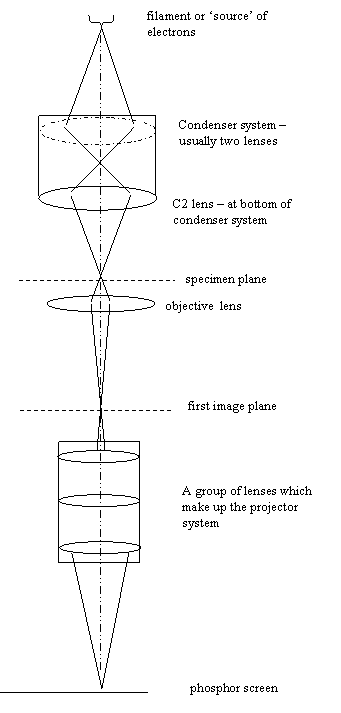The schematic diagram
Take a look at the schematic diagram of the microscope:
there is usually one posted on the wall of the laboratory,
or you may be able to find one in the instruction manual.
This next figure is a minimal schemetic, you should be able to find
a much better picture of your particular microscope.

On the equivilant diagram for your particular make of microscope, find
the most important lens, the objective. Work from
there, find the specimen, the condenser lenses (somewhere
above the objective), the diffraction and projector lenses
(somewhere below the objective). Find as many double
deflection coils as you can: between the gun and condensers,
the condensers and the specimen, and the diffraction lens
and, possibly, within the projector lenses. Find all the
aperture mechanisms. Can you see the stigmators (often left
out of such diagrams). Does it make sense? Ask the teacher
if there is something you donít understand.
How many variables are there in an electron microscope?
Well, let's count them:
- - The setting or current through each lens (about 7 variables)
- - The setting of each double-deflection coil and their rocking points for both shift
and tilt: for three sets, thatís 4 settings for each x and y: a total of 24 settings.
- - At least three sets of stigmators: another 6 variables.
- - The physical height of the specimen, the physical aperture settings,
and some physical alignments we havenít worried about: another 10 or so variables.
Luckily, we donít have to constantly change all the 50
variables to hand: but itís worth knowing what variables
exist. The main thing is to understand each lens can be
shifted or tilted, stigmated and focussed and may or may not
have an aperture. Most of the time, we try to leave the
most important variables constant, although if someone else
has used the microscope before you, donít count on them
being aligned.



Copyright J M Rodenburg
|

